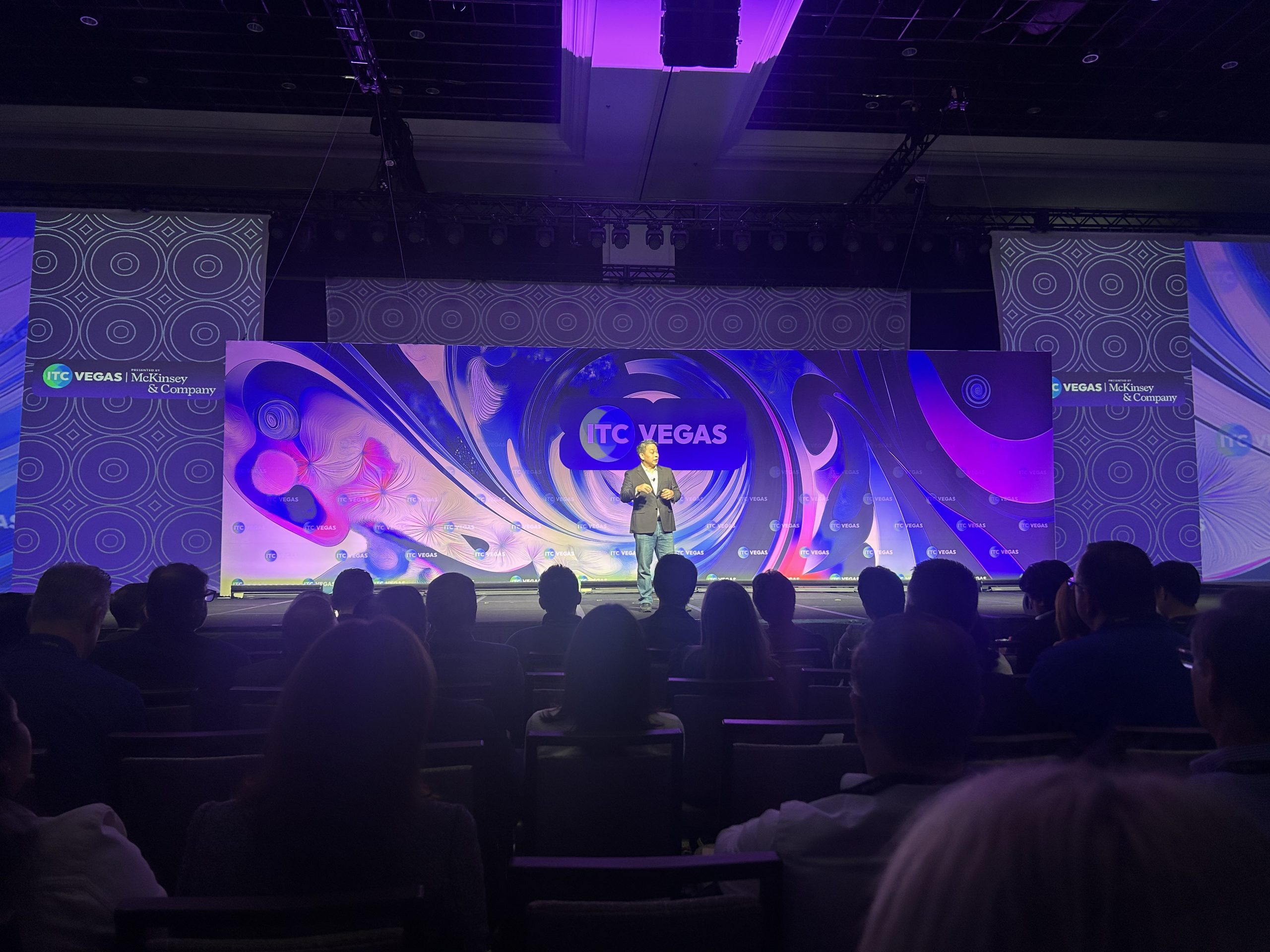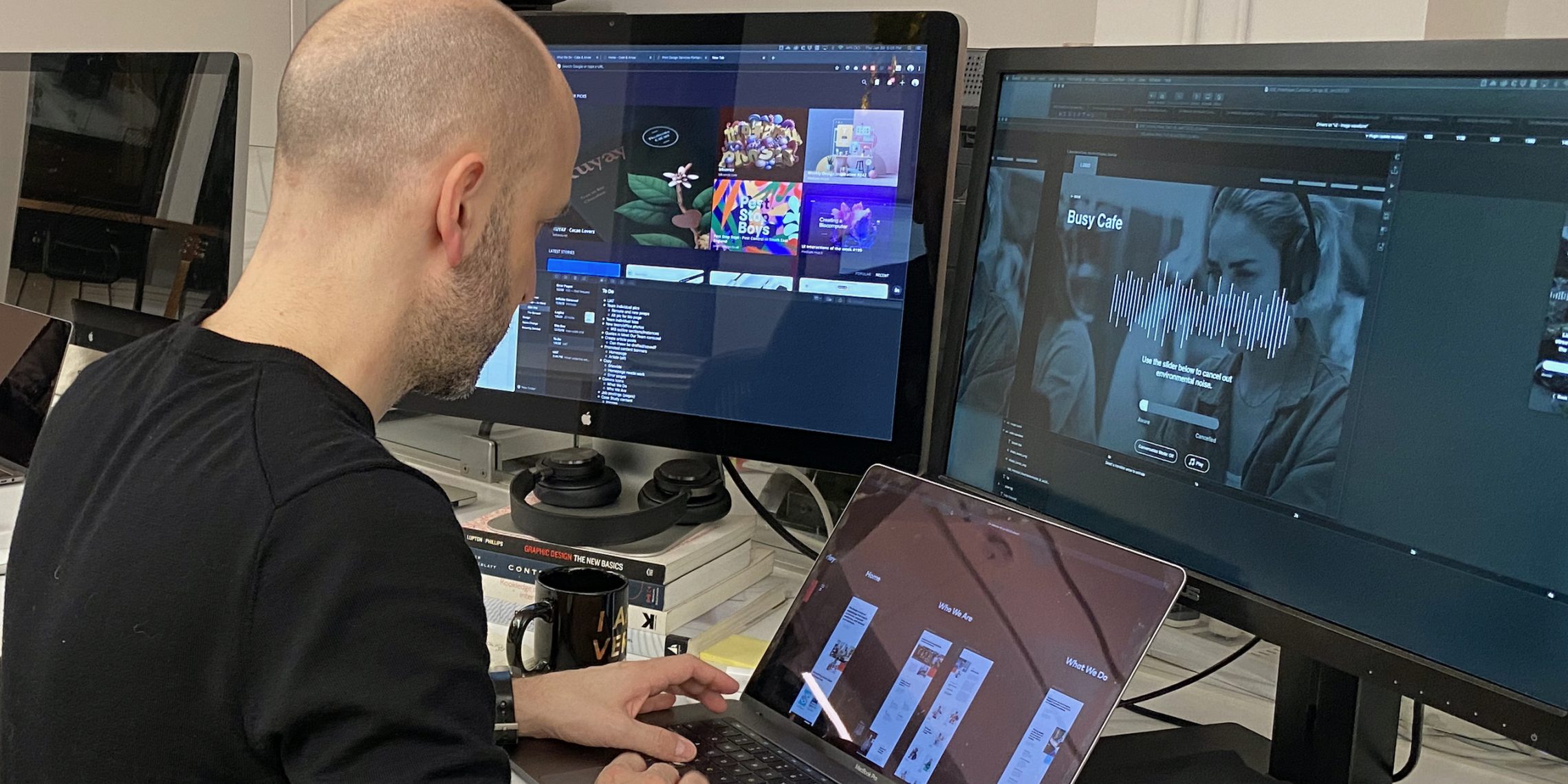
Last week, the Cake & Arrow team made our yearly pilgrimage to ITC Vegas, joining more than 9,000 insurance innovators, investors, and incumbents to connect with clients, exchange ideas, and take the pulse of where the industry is headed.
All signs point to AI. No surprise there. But this year, a question lingered beneath the buzz: Is AI all there is? What happened to climate change, customer centricity, and the many compounding risks that are taking shape before our eyes?
The insurance industry’s appetite for what’s new is insatiable. But while AI still reigned supreme, the talk of transformation gave way to something more grounded than in recent years: a collective curiosity about how, and ultimately if, AI can truly be something new for insurance—and when.
Across stages and ballrooms, roundtables and panels, the AI-themed expo floor and beyond, presenters, panelists, and sponsors grappled with the intrinsic complexity of insurance: the cultural hurdles, the data challenges, and the enigmatic humans at the heart of every technological transformation. For every promise of disruption, there were reminders that AI without empathy, strategy, and structure leads nowhere.
If you attended enough of the sessions, you would have noticed what we did: an apparent dissonance between the conference’s hype machine and the grounded reality voiced on stage. That tension—between AI hype and AI realism—became the unofficial theme of ITC Vegas 2025.
Here are six takeaways that stood out.
1. The shift from generative to agentic to industrialized AI
“AI is a fabric, threaded through the infrastructure.” – Jim Amarando, Senior Technical Solutions Consultant, Sureify
The metaphor of AI as fabric came up in more than one session, describing a shift in how the industry is thinking about AI.
The recent MIT report finding that 95% of generative AI pilots produced no value may help explain this shift. While last year’s buzz centered on generative AI, this year the focus was on agentic AI. Instead of chatbots, the conversation was about infrastructure, aka “fabric.”
As Jim Amarando of Sureify noted, “AI is not another tech stack or a layer on top of something. AI is a fabric, threaded through the infrastructure.” He implored his audience to think less about individual use cases—which, he insinuated, are often little more than innovation theatre—and more about how AI can transform entire ecosystems. Conversations around improving operational efficiencies, standardizing data, and using agentic AI to enable industrialized AI were front and center.
This perspective resonated throughout the conference as speakers discussed how AI can improve the performance of back-end systems, paving the way for broader customer-facing applications.
In one panel, Alex Cox (DXC), Chad Hersh (AWS), and John Carelli (ServiceNow) discussed how they are attempting to use agentic AI to re-engineer the flawed processes upon which much of the insurance value chain is built, with the ultimate goal of unlocking data to enable true innovation for customers.
The logic driving many of these sessions was: first, improve operations; then enhance sales or business development; and finally, apply AI to risk consulting or advisory services.
Still, the hype machine was in full swing. Many conversations still focused more on the promise of agentic AI than on actual success stories.
As Marcus Ryu, founder and former CEO of Guidewire, observed in his excellent keynote on the final day of the conference, “Agentic AI is still well behind the promise. It’s great at generating social media slop, but we still can’t reliably get AI to schedule a meeting, book a flight, or do anything that’s actually useful.”
In other words, while agentic AI may be the industry’s best bet for turning AI investments into real value, there is still a long road ahead.
2. Employees as the new CX frontier
“It’s not just experience for the customers, we are the customers.” Max Malloy, VP of Digital Experience and Strategy, Proassurance
Paralleling the shift from generative to agentic AI is a shift in focus from customers to employees. Given the emphasis on how agentic AI can drive operational efficiency—transforming core systems, re-engineering processes, and standardizing data—this change is hardly surprising. After all, employees are the ones who stand to benefit most immediately and tangibly from these kinds of transformations.
As Jerome Simmons of Salesforce noted, many customer service representatives must navigate as many as sixteen disconnected systems to do their jobs. The sheer tedium of working within such fragmented ecosystems quickly leads to dissatisfaction and burnout—and makes it increasingly difficult to attract and retain talent—not to mention the downstream impact on customers.
Accompanying this shift from the customer to the employee is a reimagining of the employee as the customer. It’s a perspective we’ve argued elsewhere is essential to designing for complex ecosystems—viewing all users, employees, and stakeholders within the insurance ecosystem as key players who deserve the same empathy and understanding afforded to front-end customers.
Important questions driving these conversations: What does an employee’s “customer experience” look like? And how does the complexity of insurance cascade from broken systems and tools to employees, and then to customers themselves?
3. Technology transformation and cultural transformation go hand-in-hand
“Culture eats strategy for breakfast.” Colleen Thomas ((quoting the old adage), VP, Business Relationship Management & Innovation, CNA Insurance
Implicit in the idea of employees as customers is a question of culture. As Max Malloy, VP of Digital Experience and Strategy at ProAssurance, put it: “We need to build culture as much as we need to build business solutions.” In a one-on-one conversation with Nigel Walsh of ServiceNow, Malloy described how adopting service technology as a business solution also became a means of cultural transformation. IT was no longer just about closing tickets—it was about solutioning.
By using ServiceNow to bridge gaps across silos and implementing the Technology enterprise-wide, ProAssurance began to shift how employees saw their roles within the organization. Everyone, in a sense, became a “prompt engineer”—a critical voice in how business problems are solved. Gone are the days when Technology could operate in a silo.
As Alejandro Zarate stated, “Technology is not an end, but a means to providing better service. AI will break down silos and transform how IT departments operate. We, as Technology professionals, have an obligation to embed ourselves into the business, break those barriers, and see ourselves as a part of the team, as things are changing a lot.”
4. The false dichotomy of humans vs. AI
“AI can make things faster, but it can’t build relationships.” — Katie Gold, VP of insurance, TheZebra.com
Because so much of the conference programming at ITC was AI-driven and AI-led, many panelists and speakers found themselves pushed into a false dichotomy between people and AI. As discussed above, people and culture are not only the object of technological innovation but also the means by which it is most impactful, and there was an almost universal acknowledgment that people are at the heart of what is good about insurance, and the force should be driving innovation.
Still, as much as speakers tried to push back, conversations about how to innovate in insurance still began with the tech, not with the people and the problems they face —whether employees or customers.
We heard a lot of: “Scaling is about knowing when to use people and when to use technology,” which, to a certain extent, is true, but also levels the playing field. People and tech are seen as cogs in the wheel of insurance. The attitude was more or less” insert human here,” rather than centering humans experience as the driving force behind innovation and tech.
Some approached this tension more fruitfully. Clarifying the roles of humans and technology.: AI can gather and clean the data, whereas humans provide the insight. In other words, humans create the meaning.
This insight—that people humans create meaning from data—is especially important in conversations about personalization. As Matt Battersby, SV and Global Head of Research and Development at RGA, pointed out, “we have the data, but we often have the wrong data.” Or, in other words, we know what people do, but we don’t know why. We need people to interpret data, ask the right questions, and surface insights, to understand the why.
As Maren Dennis, Claims Transformation Manager at Markel, put it: “Insurance is about people. When we can make the tools and tech relatable to real people — putting it in the context of what does this mean for me? and how can I use it?— it becomes easy, and people become early adopters and advocates. This can help us put that heart and personal stuff back into insurance, in this industry that has become so process and data-driven.”
5. Compounding risk demands compounding innovation
“Insurance as an industry is fighting yesterday’s war instead of what is in front of us” – Ashish Srivastava, Head of North America Insurance & Risk Management, Blackstone Real Estate
Among the most enlightening presentations at the event was Ashish Srivastava’s discussion of emerging risks and how the insurance is and should be responding. Srivastave laid out the increasing complexity and uncertainty of risk, along with unprecedented risks, related to CAT events, trade, workforce, and Technology. While the risk landscape evolves daily, the industry moves much more slowly and, according to Srivastava, is still busy trying to solve yesterday’s problems while today’s problems pass it by.
He describes a world where the insurance industry isn’t just mitigating its own risk, but doing the real work of insurance: mitigating society’s risk. He laid out three questions everyone in the industry should be asking: Are you removing friction? Are you able to prevent losses? Are you providing insights that will lead to better risk management?
These are the questions that should be driving innovation in the industry.
Yet emerging risks and risk mitigation accounted for only a fraction of the stage time.
Consumed with discussions about how AI will solve all the problems in the industry, few were talking about the new problems it might create (think the costs of data centers, workforce replacement, fraud).
When asked on stage by Contessa Brewer, who covers insurance for CNBC, about AI fraud, Kyle Nakatsuji, CEO and Co-founder of Clearcover, acknowledged that it is happening… “While AI opens many doors, it also introduces new risks.” Yet he didn’t seem to take it seriously or say much about how someone in his position might mitigate these risks.
And this is the problem. As Ashish Srivastava pointed out, compounding risk demands compounding innovation. But when the insurance industry’s largest technology conference hardly even acknowledges these compounding risks, how can we expect innovation to keep pace, let alone serve the proper ends?
Most innovation is around increasing efficiencies. Efficiencies that the industry is betting it will capture in profits. But how will these efficiencies benefit people outside of the industry? How will they prevent losses, help individuals, businesses, and society better manage risk?
In a panel on emerging risks, underwriter Angela Grant made the point that “People purchase promises in exchange for a premium. If that service experience is terrible, it doesn’t matter how big or great your product is, because a good experience is a part of the promise they bought.”
If the industry isn’t delivering on this promise, especially in a world where risks are evolving rapidly, what exactly will people be buying?
6. Respecting complexity while embracing simplicity
“Don’t trivialize insurance. It’s not simple.”- Peter Settel, President and CEO, Bold Penguin
One of the most potent undercurrents at ITC Vegas was the tension between complexity and simplicity. On one hand, speakers like Marcus Ryu and others implored us to respect the complexity of insurance—and the reasons it exists. It’s an industry that has persisted for centuries because it’s essential. But longevity comes with baggage: inefficient processes, legacy systems, and layers of regulation. That regulation, while often a source of frustration, also protects consumers and holds the industry accountable to its promises.
At the same time, this complexity has made insurance an easy target—a punchline for inefficiency in a world obsessed with speed and frictionless experiences. The counterpoint, echoed across sessions, was a call for simplicity: the single-click ideal, the “Amazon effect,” the expectation that every interaction should be seamless.
But as John Almasan, Senior Managing Director and Global Head of AI and Emerging Tech at TIAA, rightly observed, “We say we want to make things simple, but we make them more complex.” The problem, he argued, is that we don’t really know what “simple” means. Instead, we chase proxies—fewer clicks, plainer language, no friction.
True simplicity, however, isn’t the absence of friction. Oversimplifying insurance can obscure its purpose, diminish its value, and leave customers in the dark. It can, in the words of Peter Settel, risk “trivializing insurance.”
Just as we have argued elsewhere, Almasan advocated instead for education, guidance, and transparency: empowering customers not just to buy insurance easily, but to understand what they’re buying and why it matters.
In other words, respecting the complexity of insurance might mean inserting a little thoughtful friction into an experience, as this friction might be precisely what builds understanding, confidence, and ultimately trust—something the insurance industry is sorely lacking.
From Hype to Humility
If there was one overarching lesson from ITC Vegas, it was this: AI maximalism may finally be giving way to AI realism. The wild predictions of the past few years are slowly being replaced by pragmatism. As Marcus Ryu of Guidewire reminded attendees in his closing keynote, “maximalist predictions never come true.”
His remarks captured the grounded tone that pushed against the marketing hyper of ITC Vegas, offering three lessons worth carrying forward as the industry navigates its next chapter:
- Be humble in predicting the future—especially when others are not. The hype cycles will always spin faster than the realities of implementation. Real innovation requires patience, experimentation, and an honest reckoning with what’s actually working.
- Respect the reality of enterprise IT. The “infernal, fractal-like complexity” of insurance systems is real—and deeply entrenched. Getting systems to talk to each other, let alone evolve together, is hard. True transformation begins with acknowledging and working through that complexity, not wishing it away.
- Love insurance. This industry isn’t boring—it’s thrillingly meaningful to people on the worst days of their lives. At its best, insurance offers empathy in the form of security, and that’s something worth honoring and protecting as Technology reshapes it.
Taken together, these lessons cut to the heart of what we heard again and again throughout the conference: AI success won’t come from speed or spectacle, but from substance. Innovating in the industry is about testing, learning, failing fast—and doing the unglamorous work of cleaning up data, processes, and transforming culture before expecting results.
The companies that will lead the next chapter of insurance aren’t necessarily the ones experimenting the most—they’re the ones integrating the lessons of those experiments into real systems, fundamental strategies, and real human workflows that solve problems and create value for people.
Because in the end, AI won’t build the future of insurance. People who know how to wield AI with empathy, insight, and love for the work itself will.

